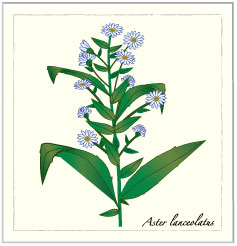Description: This native perennial plant is 1-3½' tall, branching occasionally. The height of this plant is variable, depending on the moisture regime and levels of disturbance. The central stem is grooved and has lines of small white hairs. It is green on new growth, but eventually becomes brown and woody in appearance. The hairless alternate leaves are up to 5" long and 1¼" across, becoming much shorter and more narrow as they ascend the stems. They are lanceolate or narrowly ovate,  have margins that are smooth or slightly serrate, and are sessile or narrow into a petiole-like base. Sometimes the foliage becomes purple during the fall in response to cold weather. The daisy-like composite flowers are ½–¾" across, with 20-40 white ray florets surrounding numerous yellow or reddish disk florets. There is no noticeable floral scent. The composite flowers are arranged as a panicle in the upper part of the plant, and bloom during the fall for 1-2 months. The achenes are light brown, flattened, and slightly hairy, to which are attached tufts of white or light brown hair. Dispersion of the achenes is by wind. The root system is fibrous and forms long creeping rhizomes, especially in moist areas. Sometimes this plant will form dense colonies.
have margins that are smooth or slightly serrate, and are sessile or narrow into a petiole-like base. Sometimes the foliage becomes purple during the fall in response to cold weather. The daisy-like composite flowers are ½–¾" across, with 20-40 white ray florets surrounding numerous yellow or reddish disk florets. There is no noticeable floral scent. The composite flowers are arranged as a panicle in the upper part of the plant, and bloom during the fall for 1-2 months. The achenes are light brown, flattened, and slightly hairy, to which are attached tufts of white or light brown hair. Dispersion of the achenes is by wind. The root system is fibrous and forms long creeping rhizomes, especially in moist areas. Sometimes this plant will form dense colonies.
Cultivation: The preference is full or partial sun and moist conditions. Favored locations are poorly drained areas that form pools of water temporarily, but later dry out. This plant will tolerate average levels of moisture and some drought, but won't grow as large, and the lower leaves may shrivel away. The soil can contain loam, clay, gravel, or even large rocks – this plant doesn't seem to care. If anything, poor soil is preferred. Some foliar disease may occur, such as patches of rust or powdery mildew, but the foliage is usually in good shape when the plants bloom during the fall.
Range & Habitat: Panicled Aster occurs in most counties of Illinois, and is fairly common. Habitats include moist black soil prairies, openings and edges of floodplain forests, moist meadows along rivers, thickets, gravelly seeps, borders of ponds and lakes, edges of marshes, roadside ditches, gravelly areas of junkyards, fence rows, pastures, and abandoned fields. This plant often thrives in disturbed areas.
Faunal Associations: Many kinds of insects visit the flowers, including long-tongued bees, short-tongued bees, wasps, flies, butterflies, skippers, moths, ants, and beetles. Among these, bees, wasps, and flies are probably the most common visitors, although there is significant variation across localities. When it occurs in large colonies, Panicled Aster is an important source of pollen and nectar for these insects because it is one of the last wildflowers to bloom during the fall. The caterpillars of several species of moths feed on various parts of this and other asters. To some extent, deer and rabbits browse on the foliage. The seeds and foliage are a minor source of food to the Wild Turkey.
Comments: This is a showy plant when in bloom, even though it is often treated as an unwanted weed. This aster can be hard to distinguish from others with small white flowers. It has several features that, when they are considered together, are useful in making a correct identification: 1) the compound flowers are usually ½" across or slightly more, 2) the compound flowers have at least 20 white ray florets, 2) the leaves are always lanceolate or narrowly ovate, and never heart-shaped at the base, 3) the leaves are hairless, and 4) the stems have lines of fine white hairs. Regarding nomenclature, alternative common names for this plant are 'Tall White Aster' and 'White Field Aster.' In the past, it has been assigned the scientific names Aster paniculatus and Aster simplex.